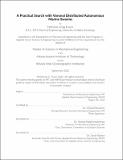A Practical Search with Voronoi Distributed Autonomous Marine Swarms
Author(s)
Evans, Nicholas Craig
DownloadThesis PDF (9.001Mb)
Advisor
Benjamin, Michael
Terms of use
Metadata
Show full item recordAbstract
The search for underwater threats in littoral regions is a problem that has been researched for nearly a century. However, recent developments in autonomy and robotics have made this issue more complex. The advent of capable autonomous underwater vehicles presents a 21st century flare to this traditional problem. These vehicles can be smaller, quieter, and expendable. Therefore, new methods and tactics used to detect and track these vehicles are needed. The use of a swarm of marine robots can increase the likelihood of uncovering these threats. This thesis provides various Voronoi partition-based methods to autonomously control a swarm of identically capable autonomous surface vessels in a limited coverage and tracking problem. These methods increase the probability of interdiction of an adversary vehicle crossing a defined region. The results achieved from Monte Carlo simulations demonstrate how different protocols of swarm movement can improve detection probability as compared to a stationary swarm provided the detection capability does not change. The swarm control algorithms are employed on Clearpath Heron USVs to validate the autonomy algorithms.
Date issued
2022-09Department
Massachusetts Institute of Technology. Department of Mechanical Engineering; Joint Program in Applied Ocean Science and EngineeringPublisher
Massachusetts Institute of Technology